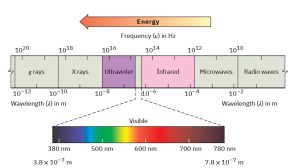28 Electromagnetic Radiation and Molecular Spectroscopy
Chapter 28 Learning Objectives
- Be able to name the various EM waves.
- Be able to define frequency and wavelength of a wave.
- Be able to arrange the different EM radiations based on their frequencies, wavelengths and energies.
28.1 Introduction
Electromagnetic radiation is the radiation composed of oscillating electrical and magnetic fields. The electromagnetic spectrum covers the radiation in very broad range from gamma rays (emitted by the nuclei of certain radioactive elements), X-rays (used for medical examination of bones), to ultraviolet (UV) light (is responsible for sunburn, can also be used for dis-infection purpose), microwaves, and radio-frequency waves (used for radio and television communication, and of the cell phone signal). Visible light, the radiation that is visible to our bare eyes and what we commonly refer to as “light”, just accounts for a very narrow band out of the full electromagnetic spectrum (Figure 28.1).

Figure 28.1 The Electromagnetic SpectrumElectromagnetic radiation exhibits wave-like properties.
As a general property of waves, the wavelength (λ, Greek ‘lambda‘) and frequency (ν, Greek ‘nu’, in unit of Hz or s-1, 1Hz = 1s-1) of electromagnetic radiation fits in the formula of:
c =λν Formula 28.1
where c is the speed, usually referred to as the “speed of light”, with the constant value of 2.998×108m/s in vacuum (the speed of light in air is a little bit slower than this constant but is usually regarded as the same). Because electromagnetic radiation travels at a constant speed, wavelength (λ) and frequency (ν) are inversely proportional to each other, the longer waves have lower frequencies, and shorter waves have higher frequencies.

Figure 28.2 Wavelength
The energy of electromagnetic radiation can be calculated based on formula:
E = hν= hc/λ Formula 28.2
where E is energy of each photon in unit of Joule (J) and h is the Planck’s constant with value of 6.626×10-34J·s.
So radiations with higher frequencies correspond to higher energy. High energy radiation, such as gamma radiation and X-rays, is composed of very short waves – as short as 10-16m. Longer wavelengths are much less energetic, and thus are less harmful to living things. Visible light waves are in the range of 400 – 700 nm (nanometer, 1nm = 10-9m), while radio waves can be several hundred meters in length.
For an account on the applications of EM radiation, view the following playlist from NASA:
In a molecular spectroscopy experiment, electromagnetic radiation of a specified range of wavelengths is allowed to pass through a sample containing a compound of interest. The sample molecules absorb energy from some of the wavelengths, and as a result jump from a lower energy ‘ground state’ to some higher energy ‘excited state’. Other wavelengths are not absorbed by the sample molecule, so they pass on through. A detector records which wavelengths were absorbed, and how much were absorbed.
As we will see in this chapter, we can learn a lot about the structure of an organic molecule by quantifying how it absorbs (or does not absorb) different wavelengths in the electromagnetic spectrum. The IR spectroscopy involves absorption of radiation in the infrared region and radio waves are applied in the NMR technique.

